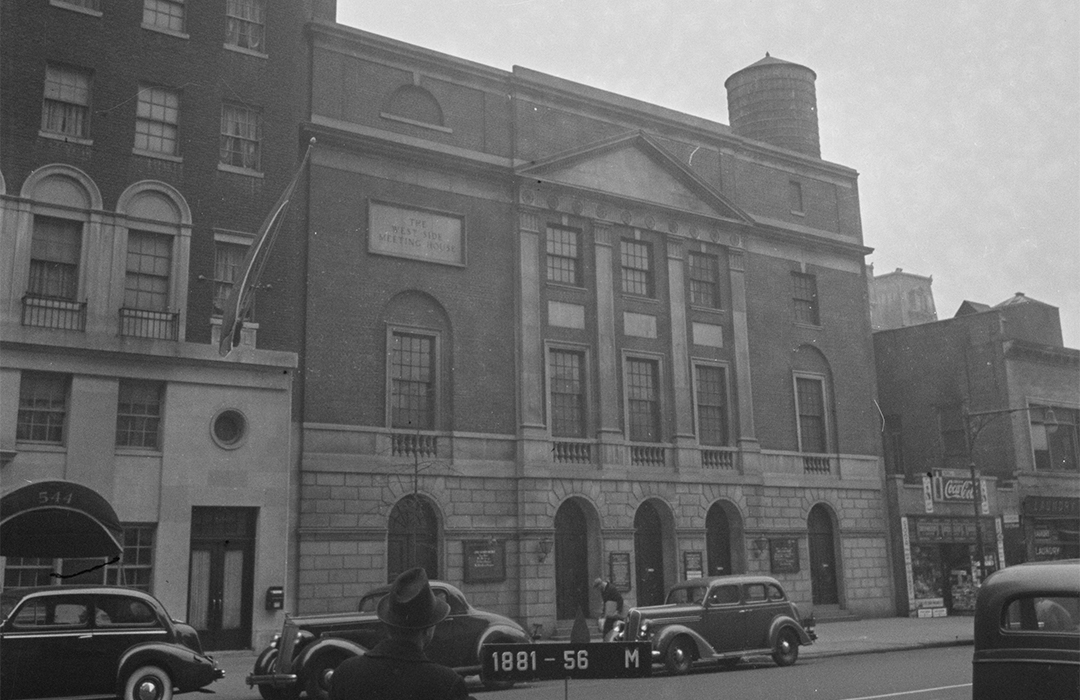
West Side Unitarian Church (Congregation Ramoth Orah)
550 Cathedral Parkway
by Tom Miller
The trustees of the Unity Congregational Society of New York (organized in March 1886) hired the architectural firm of Hoppin & Koen to design its new house of worship at 548-550 West 110th Street (later Cathedral Parkway) in 1921. Once established in its new home, the congregation would change its name to the West Side Unitarian Church.
Construction cost $400,000 (more than $7.25 million today) and was completed the following year. On the evening of October 15, 1922, the structure was dedicated “in the presence of 300 members of the congregation,” as reported by The Evening World. The article called it “a handsome structure in Colonial style with a light cream interior and blue dome.” The services were conducted by the congregation’s pastor, Rev. Charles Francis Potter. According to The Christian Register on June 16, 1921, the auditorium could seat 600 worshipers, adding, “The seating capacity can be increased to one thousand by opening doors to another hall on the first floor of the parish house.”
Rev. Potter was an author and theologian, well known for his progressive viewpoints. Among the most shocking to some was his support for the theory of evolution. That was evident in the spring of 1924 when sculptor Carl E. Akeley submitted a bronze statue, The Chrysalis, to the exhibition of the New York Academy of Design. The New York Times explained that it “depicts a young man emerging from the form of a gorilla.” The sculpture was rejected by the Academy “on the ground that it lacked merit,” said the newspaper.
In response, Rev. Potter invited Akeley to install the statue at the West Side Unification Church. The unveiling took place on the Sunday after Easter “as part of the celebration of ‘Evolution Day,’” reported The Times. Potter said, “When a man of science, who is also a great sculptor, has produced such a masterpiece as ‘The Chrysalis,’ which has a real spiritual message for the men of today, surely the Church should recognize his work.”
“I am not animated by any personal feeling against Mr. Potter, but what he is doing is the glorification of bestiality.”
Dr. John Roach Straton, pastor of Calvary Baptist Church, was not moved. He told The New York Times, “I am not animated by any personal feeling against Mr. Potter, but what he is doing is the glorification of bestiality.”
The following year, educator John T. Scopes was scheduled to be tried in Dayton, Tennessee for teaching evolution in a public high school. In his sermon on June 14, 1925, Potter addressed the upcoming trial, saying in part, “If the Anti-Evolutionists in Tennessee were aware of the existence of any other religions than their own, they might realize that it is the very genius of religion itself to evolve from primary forms to higher ones. Evidently we have been very much mistaken about our civilization here in the United States. England is aghast at the poverty of our mental equipment. It is not only the Tennessee people who should be ashamed; we are all to blame.”
Potter’s stance on evolution caught the attention of attorney Clarence Darrow. On June 29, 1925, the New York Evening Post reported, “The Rev. Charles Francis Potter, retiring pastor of the West Side Unitarian Church, will be a witness in the Scopes trial at Dayton, Tenn.” It is unclear whether Potter actually testified, but he was a close advisor to Darrow on nuances in Bible.
As the New York Evening Post had intimated, Potter had already tendered his resignation. On May 4, 1925, The New York Times called Potter “one of the leading Modernists of the city,” and advised that he would be taking the position of Executive Secretary of Antioch College, in Yellow Springs, Ohio.
Potter was replaced by the Rev. Dr. A. Wakefield Slaten, who, The New York Times reminded its readers, “more than two years ago was ousted from a professorship in the William Jewell Baptist College at Liberty, Mo., because of his modernistic views.”
Slaten’s pastorship would be short-lived. He resigned in January 1929 because of illness. In his letter of resignation, he urged the congregation, “If you have given little thought to the church’s need of your financial support, now is the time to fill out a weekly pledge card generously.”
His declaration was ominously prescient. Eight months later, the Stock Market crashed, triggering the Great Depression. On February 26, 1931, The New York Times reported, “The West Side Unitarian Church, one of the oldest liberal congregations in the city, has been so seriously affected financially by the business depression that it may have to merge with another group or go out of existence.” The congregation chose the former option. Nine months later it merged with the Community Church. On November 14, 1931, The Times reported, “the West Side Church property…was closed and eventually it is to be rented or sold.”
In 1942, Rabbi Robert S. Serebrenik, formerly the chief rabbi of Luxembourg, founded Congregation Ramath Orah. He valiantly remained in Luxembourg after the Nazi invasion and was responsible for the saving of thousands of Jews. On June 10, 1941, when the danger became too intense, he and his wife, the former Julia Herzog, boarded the Portuguese ship Mouzinho with 61 other refugees headed to New York City. The name of his new congregation, which means “light mountain,” was a loose translation of Luxembourg, which translates to “little fortress.”
NBC began a program saying “We bring you now a special broadcast of historic significance: The first Jewish religious service broadcast from Germany since the advent of Hitler.”
After serving Congregation Ramath Orah for more than two decades, Rabbi Serebrenik died of a heart attack on February 11, 1965.
It is unclear whether Rabbi Serebrenik discussed his wartime experiences with congregant Max Fuchs. On June 6, 1944, two years after Serebrenik arrived in Manhattan, Fuchs was part of the landing on Omaha Beach. Four months later, his unit was “at the edge of a fierce fight for control of the city of Aachen, Germany,” according to The New York Times. On the night of October 29, a radio correspondent for NBC began a program saying, “We bring you now a special broadcast of historic significance: The first Jewish religious service broadcast from Germany since the advent of Hitler.”
The helmeted soldiers stood in a field with artillery exploding in the background and worshiped. Twenty-two-year-old Max Fuchs served as cantor. Amazingly, not only did NBC tape the service, but in 2009, it was posted on YouTube. Writing in The New York Times on September 27, Paul Vitello said it “has drawn 310,000 hits.” Additionally, the rabbi of Congregation Ramath Orah “is insisting that he sing at services on Saturday, which is Rosh Hashana.” Fuchs protested that “his voice is not what it used to be.”
The congregation continues to worship within Hoppin & Koen’s dignified neo-Georgian building, which is little changed since its doors opened just over a century ago.
Tom Miller is a social historian and blogger at daytoninmanhattan.blogspot.com
Building Database
Be a part of history!
Stay local to support the nonprofit currently at 550 Cathedral Parkway:


